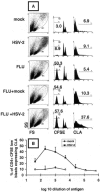Innate immune responses to herpes simplex virus type 2 influence skin homing molecule expression by memory CD4+ lymphocytes
- PMID: 16501095
- PMCID: PMC1395438
- DOI: 10.1128/JVI.80.6.2863-2872.2006
Innate immune responses to herpes simplex virus type 2 influence skin homing molecule expression by memory CD4+ lymphocytes
Abstract
Herpes simplex virus (HSV) infections of humans are characterized by intermittent, lytic replication in epithelia. Circulating HSV-specific CD4 T cells express lower levels of preformed cutaneous lymphocyte-associated antigen (CLA), a skin-homing receptor, than do circulating HSV-specific CD8 T cells but, paradoxically, move into infected skin earlier than CD8 cells. Memory CD4 T cells develop strong and selective expression of CLA and E-selectin ligand while responding to HSV antigen in vitro. We now show that interleukin-12, type I interferon, and transforming growth factor beta are each involved in CLA expression by memory HSV type 2 (HSV-2)-specific CD4 T cells in peripheral blood mononuclear cells (PBMC). A reduction of the number of monocytes and dendritic cells from PBMC reduces CLA expression by HSV-2-responsive CD4 lymphoblasts, while their reintroduction restores this phenotype, identifying these cells as possible sources of CLA-promoting cytokines. Plasmacytoid dendritic cells are particularly potent inducers of CLA on HSV-reactive CD4 T cells. These observations are consistent with cooperation between innate and acquired immunity to promote a pattern of homing receptor expression that is physiologically appropriate for trafficking to infected tissues.
Figures






Similar articles
-
Expression of cutaneous lymphocyte-associated antigen and E-selectin ligand by circulating human memory CD4+ T lymphocytes specific for herpes simplex virus type 2.J Infect Dis. 2005 Jan 15;191(2):243-54. doi: 10.1086/426944. Epub 2004 Dec 15. J Infect Dis. 2005. PMID: 15609235 Free PMC article.
-
Homing in on the cellular immune response to HSV-2 in humans.Am J Reprod Immunol. 2005 Apr;53(4):172-81. doi: 10.1111/j.1600-0897.2005.00262.x. Am J Reprod Immunol. 2005. PMID: 15760378 Free PMC article.
-
Selective Expression of CCR10 and CXCR3 by Circulating Human Herpes Simplex Virus-Specific CD8 T Cells.J Virol. 2017 Sep 12;91(19):e00810-17. doi: 10.1128/JVI.00810-17. Print 2017 Oct 1. J Virol. 2017. PMID: 28701399 Free PMC article.
-
Herpes simplex virus-2 in the genital mucosa: insights into the mucosal host response and vaccine development.Curr Opin Infect Dis. 2012 Feb;25(1):92-9. doi: 10.1097/QCO.0b013e32834e9a56. Curr Opin Infect Dis. 2012. PMID: 22143115 Review.
-
Circulating CLA+ T cells in atopic dermatitis and their possible role as peripheral biomarkers.Allergy. 2017 Mar;72(3):366-372. doi: 10.1111/all.13080. Epub 2016 Dec 15. Allergy. 2017. PMID: 27861978 Review.
Cited by
-
Peptide vaccination in Montanide adjuvant induces and GM-CSF increases CXCR3 and cutaneous lymphocyte antigen expression by tumor antigen-specific CD8 T cells.Cancer Immunol Res. 2013 Nov;1(5):332-9. doi: 10.1158/2326-6066.CIR-13-0084. Cancer Immunol Res. 2013. PMID: 24377099 Free PMC article. Clinical Trial.
-
Rapid host immune response and viral dynamics in herpes simplex virus-2 infection.Nat Med. 2013 Mar;19(3):280-90. doi: 10.1038/nm.3103. Nat Med. 2013. PMID: 23467247 Free PMC article.
-
Human CD4+ CD25 high cells suppress proliferative memory lymphocyte responses to herpes simplex virus type 2.J Virol. 2006 Aug;80(16):8271-3. doi: 10.1128/JVI.00656-06. J Virol. 2006. PMID: 16873284 Free PMC article.
-
Persistence of HIV-1 receptor-positive cells after HSV-2 reactivation is a potential mechanism for increased HIV-1 acquisition.Nat Med. 2009 Aug;15(8):886-92. doi: 10.1038/nm.2006. Epub 2009 Aug 2. Nat Med. 2009. PMID: 19648930 Free PMC article. Clinical Trial.
-
Virologic and immunologic evidence of multifocal genital herpes simplex virus 2 infection.J Virol. 2014 May;88(9):4921-31. doi: 10.1128/JVI.03285-13. Epub 2014 Feb 19. J Virol. 2014. PMID: 24554666 Free PMC article.
References
-
- Allan, R. S., C. M. Smith, G. T. Belz, A. L. van Lint, L. M. Wakim, W. R. Heath, and F. R. Carbone. 2003. Epidermal viral immunity induced by CD8alpha+ dendritic cells but not by Langerhans cells. Science 301:1925-1928. - PubMed
-
- Ankel, H., D. F. Westra, S. Welling-Wester, and P. Lebon. 1998. Induction of interferon-alpha by glycoprotein D of herpes simplex virus: a possible role of chemokine receptors. Virology 251:317-326. - PubMed
-
- Armerding, D., and T. S. Kupper. 1999. Functional cutaneous lymphocyte antigen can be induced in essentially all peripheral blood T lymphocytes. Int. Arch. Allergy Immunol. 119:212-222. - PubMed
-
- Bangert, C., J. Friedl, G. Stary, G. Stingl, and T. Kopp. 2003. Immunopathologic features of allergic contact dermatitis in humans: participation of plasmacytoid dendritic cells in the pathogenesis of the disease? J. Investig. Dermatol. 121:1409-1418. - PubMed
Publication types
MeSH terms
Substances
Grants and funding
LinkOut - more resources
Full Text Sources
Other Literature Sources
Research Materials

